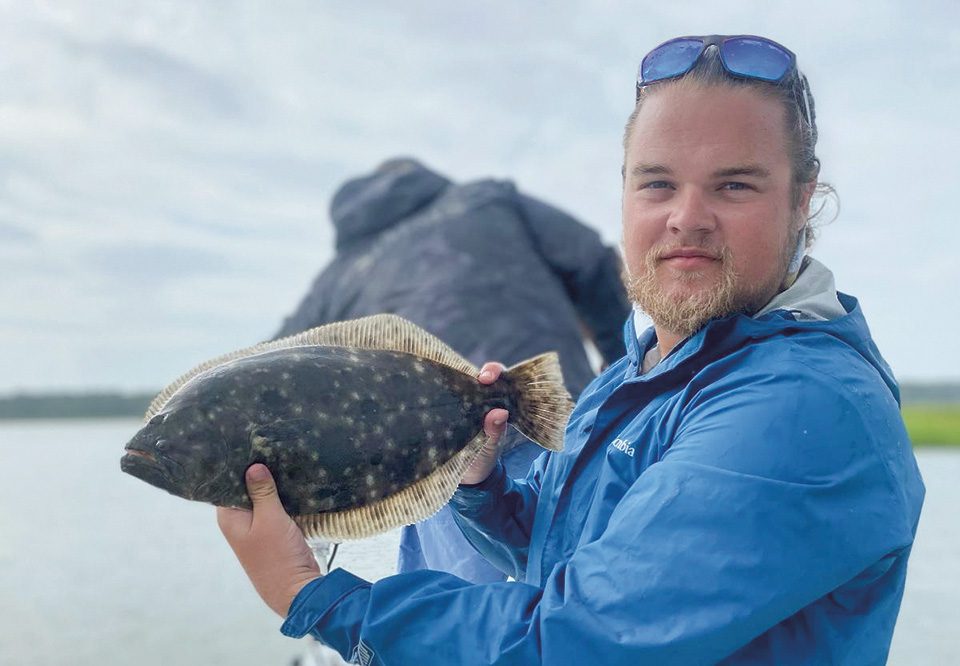By B.J. Hilton and Sean Tarpley, Ga. DNR
Flounder fishing in coastal Georgia offers anglers a thrilling pursuit, with peak seasons from April through October. Understanding the behavior, habitat and techniques for targeting this species can significantly enhance your success on the water.
Understanding Flounder Behavior and Habitat
Flounder, renowned ambush predators, can be found year-round in coastal Georgia waters. However, they become particularly abundant from early May through the fall months, favoring the warmer waters of summer. As the temperature rises, these flatfish move into shallow inland estuaries where food sources become plentiful.
These masters of camouflage rely on their ability to blend seamlessly with their surroundings, often lying motionless on the seabed awaiting passing prey. Their preferred habitats include areas with ample structure such as dock pilings, bridges, rocks, jetties and shell beds.
These structures provide hiding places for baitfish, which flounder patiently await to ambush.
Anglers may want to look for smaller creek mouths or shell beds that create water currents, pushing and funneling bait and prey down current of the structure being fished. Flounder can also be found on deep drop-offs and sharp sloping banks adjacent to man-made structures.
Tides and Feeding Patterns
Tides play a crucial role in flounder feeding behavior. While they can be caught at any tide, experienced anglers often find success during mid-falling tides, which draw bait out into the open where flounder lie in wait. A mid-incoming tide is also productive for targeting these elusive fish.
Effective Techniques for Flounder Fishing
A variety of techniques and strategies can prove successful when targeting flounder, depending on the location and specific habitat being fished. However, two fundamental principles should guide your approach:
- Bottom Dwelling Strategy: Flounder are bottom-dwelling species, so presenting your bait close to or on the seabed is essential. Whether using live bait or artificial lures, keeping your presentation near the bottom increases your chances of enticing a strike.
- Utilizing Structure: Flounder are often found close to structure, so expect occasional snags. Equip yourself with ample tackle to re-rig as needed.
Tackle and Bait Selection
The choice of tackle and bait depends on various factors such as water depth, current, weather, and structure type. Here are some effective setups:
- Live Bait Techniques: Utilize a Carolina rig with a 1/4 to 1-ounce egg sinker, khale hook, and fluorocarbon leader around docks and bridges. For submerged structures like rocks and oyster beds, consider a slip cork or popping cork rig to keep your bait just off the bottom and avoid snags.
- Artificial Lures: Opt for soft-plastic swimbaits rigged with a 1/4 to 1-ounce jig head and fluorocarbon leader. Gulp Swimming Mullet in white and chartreuse, along with other soft-plastic swimbaits, are popular choices. Slowly dragging these lures over the seabed mimics natural movements and can trigger aggressive strikes.
Avoiding Common Mistakes
One common mistake anglers make when targeting flounder is failing to keep their bait on the bottom. Adequate weight to match the current conditions is essential for maintaining proper presentation and maximizing your success rate. Flounder are not typically found eating within the upper 2/3 of the water column, and keeping your bait within the preferred strike zone will increase your chance of success.
The number one mistake anglers make when fishing for flounder is not keeping their bait on the bottom. Make sure you have enough weight for the current you are fishing in to keep the bait on the bottom and your success rate will be much higher.
For more from Georgia’s Coastal Resources Division, go to coastalgadnr.org.
